Guardsmen detonate a demolition charge as part of training during Noble Partner in Georgia, Sept. 14, 2020. The exercise is designed to enhance force readiness and interoperability.
Providing up-to-date information, news and original content on American Military issues.
Guardsmen detonate a demolition charge as part of training during Noble Partner in Georgia, Sept. 14, 2020. The exercise is designed to enhance force readiness and interoperability.
A sailor is hoisted from a Mark VI patrol boat into an MH-60S Seahawk helicopter during hoist training operations in the Arabian Sea, Sept. 3, 2020.
A soldier participates in German Armed Forces Proficiency Badge events in an undisclosed location in the Central Command area of responsibility, Sept. 5, 2020.
Army Spc. Alison Boling, assigned to the 16th Engineer Brigade, Ohio Army National Guard, wears a facemask while working out at a soft reopening of the MWR main fitness center on Camp Buehring, Kuwait, Sept. 3, 2020. Boling helped demonstrate new COVID-19 mitigation measures implemented at the gym during the soft reopening event.
Navy Petty Officer 2nd Class Marco Carrasco tests a welding device in the hull repair space aboard the USS America in the Philippine Sea, Sept. 12, 2020.
Sept. 14, 2020 | BY David Vergun , DOD News
Russian and Chinese military capabilities are growing, said the commander of U.S. Strategic Command, who outlined steps the department is taking to meet those challenges.
''Our competitors have continued to develop non-strategic and strategic capabilities in an effort to outpace us,'' Navy Adm. Charles ''Chas'' A. Richard said during a Pentagon press briefing today.
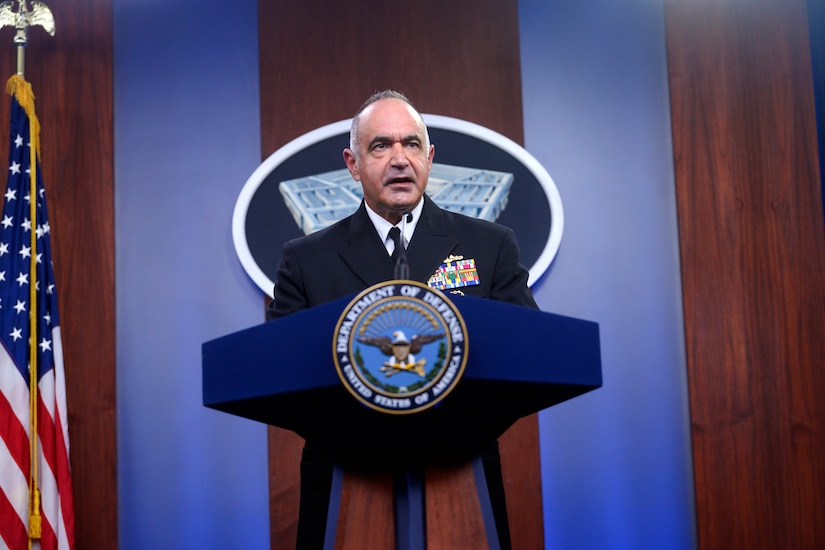
''We are on a trajectory for the first time in our nation's history to face two peer nuclear-capable competitors who have to be deterred differently, and we're working very hard to meet that challenge,'' he said.
Richard mentioned that the nations are not just increasing their nuclear capabilities, but they're also involved in military ventures in space and cyberspace and are advancing key weapons systems, including hypersonics.
''China [is] developing a stack of capabilities inconsistent with their stated 'no-first use' policy,'' he added. For instance, Beijing is now capable of threatening the U.S. homeland with its ballistic missile submarine fleet.
In response to these challenges, Richard said U.S. Stratcom has been modernizing all of its capabilities.
For instance, the Nuclear Command, Control and Communications Enterprise Center (dubbed NC3) is progressing nicely and will eventually be nested with the Joint All-Domain Command and Control, he said.
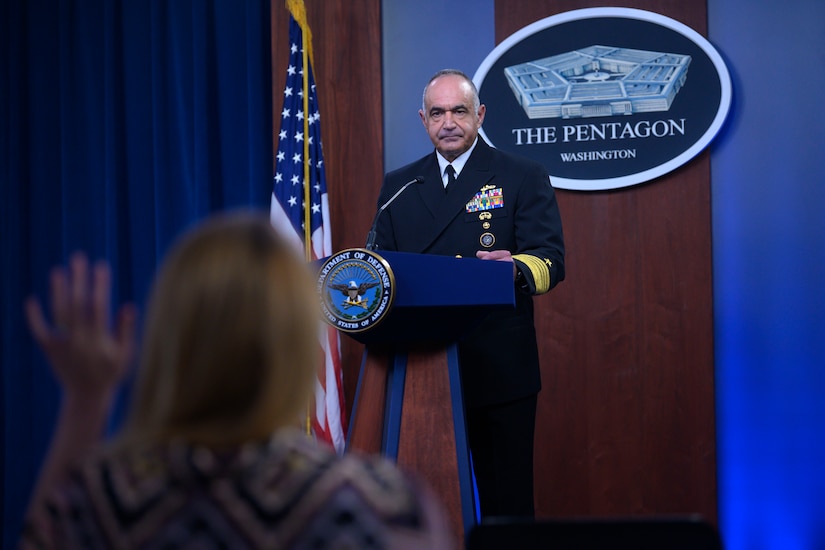
JADC2 is a combination of new technology and processes that will enable the joint force to connect sensors, data and communications with shooters. NC3 is the nuclear forces command and control element.
In another example, Richard said bomber task force missions are operating worldwide and, in particular, they're supporting allies and partners in the U.S. European Command and U.S. Indo-Pacific Command areas of responsibility.
Despite the COVID-19 pandemic, the 150,000 personnel at U.S. Stratcom are continuing to do their work, either on-site or remotely, he said.
''We are fully mission capable,'' he said. ''The bottom line is we're ready.''
A positive result of the pandemic is that personnel were able to efficiently and effectively telework and engage in distributed learning, Richard said, adding that his command will not go back to the way it did business before the pandemic, meaning he'd like to keep a lot of this capability in place permanently.
According to U.S. Stratcom's mission statement, the command's purpose is to deter strategic attack and employ forces, as directed, to guarantee the security of our nation and our allies.
A soldier conducts an airborne operation with an American flag in observance of 9/11 at Malmsheim Airfield in Stuttgart, Germany, Sept. 11, 2020.
Sept. 14, 2020 | BY Jim Garamone , DOD News
Over the past few months, there were 77,000 Army Guardsmen and over 100,000 National Guardsmen on duty, Army Lt. Gen. Jon A. Jensen, director of the Army National Guard, said during an interview.
There are 335,000 Army National Guard soldiers in the 50 states, three territories and the District of Columbia. Today, there are more than 22,000 Army National Guardsmen deployed as part of the warfighting mission for the joint force. This has been consistent since the early 2000s, the general said. "As you look into the future, you know, we're going to continue to do that as the combat reserve of the Army and as an operational reserve," he said. "But we'll also simultaneously always be that response back home, as well."
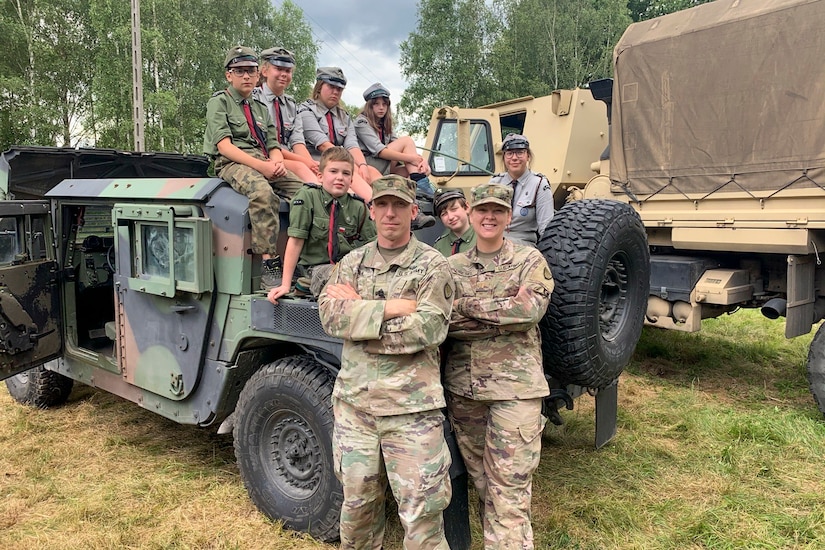
The National Guard has personnel deployed to Afghanistan, Iraq, Djibouti, Europe, the Pacific, Guantanamo and many other countries. State guardsmen also maintain contacts with many foreign militaries under the State Partnership Program.
But over the past months of this year, the National Guard has been ubiquitous: helping medical authorities combat COVID-19; working with civilian authorities to fight fires throughout the West; helping communities hit by weather events; and helping calm areas wracked by violence.
Early on, the guard was used to help civil authorities against COVID-19. "We've still got over 18,500 Guardsmen in support of COVID-19 response with more than 15,000 of them from the Army Guard," Jensen said. "I think we'll continue to do that mission, obviously, until the pandemic's over."
To date, guardsmen have administered more than 8 million COVID-19 tests. They're also helping in long-term care facilities.

"Our logistics effort has been amazing, as well, with over 350 million meals that have been delivered and 12,000 tons of bulk food," he said.
When the virus first hit, there were concerns about medical facility space. Guardsmen worked with the Army Corps of Engineers to create alternate care facilities in major cities. "Ultimately, we built a 15,000-bed capability that didn't exist prior to the pandemic," Jensen said.
The Guard has also been involved in contact tracing. That is, identifying those positive for COVID-19, then contacting those who had been in close proximity of the person with the positive case.
These missions will continue, and the guard will probably be called upon to help once a vaccine is developed and deemed safe. Jensen was clear that the guard has not been asked to do anything yet, but prudent planning requires consideration. The guard, with its all-terrain vehicles and helicopter assets, could help transport the vaccine to hard-to-reach places. Guard personnel could also help with the actual administration of the vaccine, if called upon.
"We all know that the key to this thing is going to be getting a vaccine and then getting the vaccine out to the population," the general said. "We will be ready to do whatever is asked."
And the guard is doing all sorts of other missions to support fellow citizens. The Army National Guard is actively engaged in fighting 76 wildfires in the West. This year is on track to be the worst fire season since 2003, officials said. In California alone, more than 900 National Guard personnel are helping state authorities and firefighting crews. Guard aviators rescued 159 civilians and are battling 23 fires that have burned nearly 2 million acres.
Guardsmen are also helping in Colorado, Montana, Washington, Oregon, Arizona, Idaho and Utah. They are working on 53 fires that have charred over 830,000 acres.
The year is tough. In fiscal 2018, guardsmen helped with wildland fire suppression operations for 26 fires. Last year, it was for 12 fires.
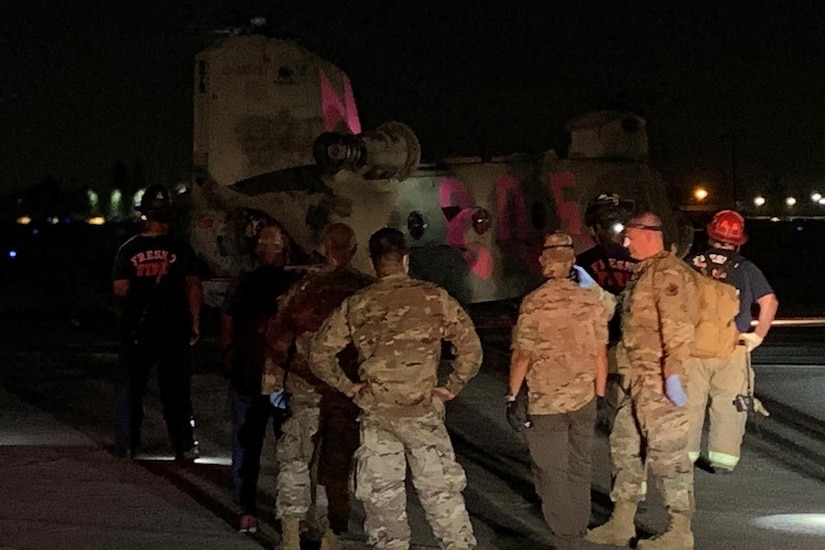
The hurricane season is also at its height. There are still more than 3,000 soldiers in Louisiana and Texas helping the states recover from Hurricane Laura. Now, Hurricane Sally is threatening the Gulf Coast.
The guard also has about 2,000 soldiers supporting the Southwest border mission. "And that mission will grow," Jensen said.
The National Guard was also called upon to help in the disturbances following the death of George Floyd in Minneapolis. Jensen — who was the adjutant general of Minnesota before taking his current job — said he also noticed the calming effect of the guardsmen. "I think the National Guard has gained a tremendous amount of public trust and confidence due to our overseas deployments," he said.
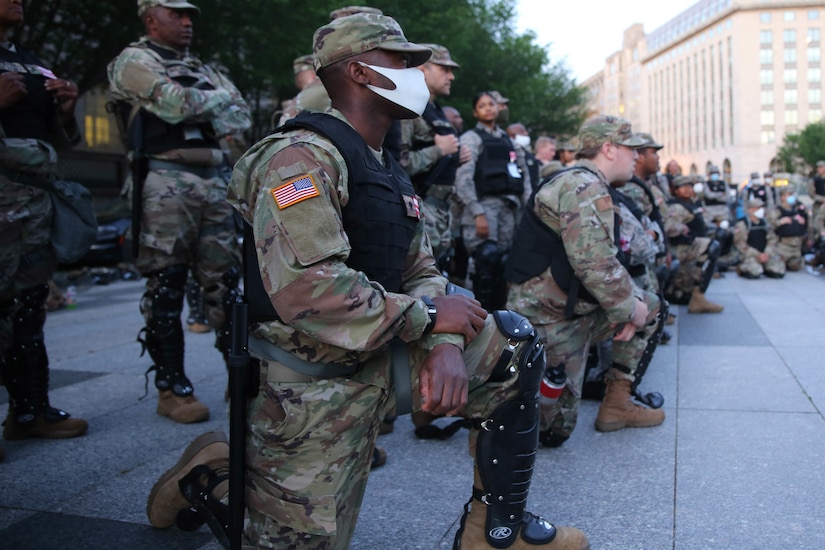
He also noted that guardsmen have been prominent in the COVID-19 response and other high-profile civil support missions dating to Hurricane Katrina. "Whether it's hurricanes or wildfires or ice storms or COVID-19, I think there is just a great amount of awareness and appreciation for what the guard has been doing since 9-11, and what the guard has continued to do," Jensen said.
The final piece of that puzzle is the guard as part of the communities they serve. "We're in over 2,600 communities across the country," he said. "In Minnesota … our little motto [is] 'We live here. We work here. We serve here.' There's just a very strong community connection to the National Guard, and that when we come, we arrive in a non-threatening way. And I think I think that has been appreciated. And I think people have responded to that."
Sept. 14, 2020
Today, the Department of Defense, on behalf of the Department of Health and Human Services (HHS), signed contracts with nine American businesses for the delivery of 73 million COVID-19 disposable isolation gowns at a cost of $335M. The contracts will support the replenishment of the HHS-managed Strategic National Stockpile and deliver by January 2021, ensuring HHS is poised to meet the Nation’s critical medical needs.
These contracts have a ceiling of $1.2 billion to manufacture up to 275 million gowns if the Strategic National Stockpile requires additional gowns.
Today’s contract awards will boost the domestic industrial base for textiles and reduce dependency on foreign sources for critical personal protective items. There was robust competition for the contracts, which were executed by the Defense Logistics Agency.
All of the gowns procured adhere to the Berry Amendment, an acquisition regulation that requires DOD to give preference to domestically produced clothing and textiles. Eight of the nine gown contract awardees are American small businesses, with the largest portion of the quantities going to a woman-owned small business.
On Friday, DOD signed contracts with five U.S. small businesses worth a maximum value of $136 million for 15 million COVID-19 reusable isolation gowns, which will also be used for the replenishment of the Strategic National Stockpile.
Sept. 14, 2020
STAFF: With us today is Admiral Chas Richard from U.S. Strategic Command. He'll be speaking about his mission set and the COVID virus. This is on the record.
And with that, sir, over to you.
ADMIRAL CHARLES A. "CHAS" RICHARD: Right. So good morning, everyone, and – I’ll go ahead, I think I'm properly socially distanced here. The -- it is -- for those of you that don't know me, I'm Admiral Chas Richard. I'm the commander of U.S. Strategic Command, and I have the privilege of leading 150,000 soldiers, sailors, airmen, Marines, civilians.
It's actually nice to see everybody's faces this time. Last time I had a chance to talk to you all, I was on a phone bridge. In fact, we didn't realize it was on television. And so it is, I think, a much better opportunity when I can actually see you.
I appreciate taking some time to have a conversation this morning. Before we get to the questions, though, let me offer you a few updates on how we're doing inside U.S. Strategic Command.
First, I'm very pleased to report that throughout the challenge that was presented to us by COVID-19, U.S. Strategic Command has and continues to be fully mission capable. And I'd like to thank my department's leadership in terms of giving us authorities, resources, and understanding of what we were up against. And that was a key in terms of our ability to be able to respond to this unprecedented threat.
The conditions in Omaha are favorable. We're adjusting workforce inside the new LeMay Command and Control Facility to adapt to local conditions. I'm at about 75 percent throttle with the rest on telework, and we're ready to go up or down as conditions dictate.
Very pleased with my component commanders, Admiral Chris Grady, General Tom Ray and -- or Tim Ray, and Dan Karbler at SMDC for the Army, who provided great leadership to adapt to their local conditions and maintain all their forces fully mission-capable.
Bottom line here is we're ready. And why is that important? I think it's important for us to remember that throughout this challenge of COVID-19, no threats went away, right? Nothing else changed, no one gave up a single nuclear weapon based on the fact of COVID-19. In fact, it's going in the other direction.
Our competitors have continued to develop both nonstrategic and strategic capabilities in an effort to outpace us. And we are going into a very different world. The -- we are on a trajectory for the first time in our nation's history to face two peer nuclear-capable competitors who have to be deterred differently, and we're working very hard to meet that challenge.
I think we all know the threat that Russia poses to us, modernizing strategic, conventional, space, counter-space, cyber, they're developing hypersonics, and their gray zone actions. And it's not only what they're developing, it's what they're doing.
China's similar, right? I think you all have seen the recent China military report, I think it's an excellent explanation in terms of what China's overall strategy is, and explains the why behind the things that we see them doing, particularly in my mission sets. Again, looking to -- we like talking about the fact that they're going to double their stockpile by the end of the decade.
I'd ask you to consider that just measuring a nation's stockpile is a relatively crude measure of their capabilities. You have to look at the totality of it, the delivery systems, what they're capable of, what their readiness is. And China in particular is developing a stack of capabilities that, to my mind, is increasingly inconsistent with a stated no-first-use policy.
We're ready. I think one visible demonstration of that is the bomber task force missions that we've been operating worldwide. We're pleased to be able to support U.S. European Command and Indo-Pacific Command in providing forces that they use to accomplish our objectives. My I.C. wings, my SSBN groups are also continuing to mitigate risk from COVID-19 operations, and again they're fully mission-capable.
The -- I'm also pleased to report that the department has made tremendous progress in its nuclear command and control capabilities. It was a wise decision to establish the NC3 Enterprise Center and we are moving out and making great strides in making sure that the NC3 systems that we have will continue to pace the threat. They're certainly fully mission-capable today, I have absolute confidence in them. And I'm also pleased that we're going to be able to say that going into the future.
We do see future NC3 fitting hand-in-glove into the broader department's Command and Control JADC2, if you will, framework. And we are able to present to the secretary and the chairman an overall view of their NC3 in a way we haven't been able to do in many years.
So bottom line here, as I close and get ready for some questions, we're ready but we'll continue to have to work to maintain our -- in a world with changing threats on us. I'm very proud of the men and women of U.S. Strategic Command.
And I want to leave you with one last thought. The way we have put the strategic forces and capabilities of this nation together from day one, we were always very humble in our ability to anticipate threats -- we always built in margin, we always built in hedge, not only for the risks that we could foresee but the risks that we might not be able to foresee.
And so a big piece of why I can stand in front of you and tell you that we're fully mission capable is because of wise decisions made by my predecessors to give me capability, flexibility and everything I needed to be able to respond to the thing that we didn't see coming, and that's an important thing I -- I -- an important attribute I think we need to keep in mind as we think about the recapitalization of these systems.
And with that, I'd be happy to take questions.
STAFF: Thank you, sir. We'll start on the phone line with Bob Burns.
Q: Thank you. This is -- this is Bob.
Admiral Richard, you mentioned the bomber task force missions of recent months -- excuse me. There have been a number of incidents lately that the Russians have characterized much differently -- for example, just a few days ago, the head of the Russian Air Force was saying that a number of times in August and September that B-52 bombers have flown close to Russian borders and that he saw this as both hostile and provocative action by the United States.
I'm wondering if you could say whether, you know, you have concerns about the escalation of tensions with Russia, you know, that could lead to actual conflict? Thank you.
ADM. RICHARD: I -- so, Bob, thank you for the question and it's nice to hear from you again, sir.
I think the bomber task forces are a -- a iconic example of how we're executing the National Defense Strategy in terms of us being strategically predictable yet tactically unpredictable.
I'm very pleased in the support that we're providing to the other combatant commands and I think that they have done a very good job of showing that the United States is capable of operating anywhere in international air space and is ready to meet any challenge that is presented to us.
STAFF: Okay. We'll come back to the room with Barbara with CNN.
Q: Two quick things, if I may.
On COVID, first of all, could you just walk us back to this past winter when Strategic Command, because it's so critical, really began to understand -- when did you know the severity of the potential COVID threat?
But my other question perhaps first is you referenced China and no-first-use policy. What's your thinking on this? Can you talk about that a little more? Do you believe that China either is rejecting the notion of first-use, is moving towards a no-first-use? What's your assessment of that and what does that mean for the United States?
ADM. RICHARD: So, ma'am, I would start with, as a military commander, what I look at more is another nation's capabilities, less about what their stated intentions are, and I see China developing a stack of capabilities that would be inconsistent with a no-first-use policy. It's not my place to judge whether they intend to honor that or not.
What I can tell you is -- is that they certainly have the capabilities to execute any number of deterrent or employment strategies that are seemingly inconsistent with a -- and a no-first-use policy really drives you back quickly to a minimum deterrent strategy and it just looks inconsistent to me and it's my responsibility to make sure that I have thought through what we have to do to deter what they're capable of doing as opposed to what they say they're going to do.
Q: So an outright offensive attack is what you're saying?
ADM. RICHARD: No, ma'am, I didn't say anything about offensive attack. I'm talking about deterring what they're capable of doing.
Q: And on COVID this past winter, when did you -- when did you really know and told by your people that it was a -- a -- a serious threat?
ADM. RICHARD: Ma'am, we are constantly looking at any number of threats and we take all of them seriously. That -- you know, it's one thing -- I believe the Department of Defense has a plan for just about everything. We had a plan in place for a pandemic infectious disease and we simply, very early on, December time frame, started looking through "what if" scenarios and started devising mechanisms, strategies to address that and that -- that process served us very well.
Q: Okay.
STAFF: Okay, we'll stay here in the room with Lucas from Fox.
Q: Lucas Tomlinson, Fox News.
Admiral, why do you need a low-yield nuclear warhead on your ballistic missile submarines?
ADM. RICHARD: Well, I think the justification for the low-yield ballistic missile was very well laid out in the Nuclear Posture Review and then captured inside our National Defense Strategy. In order to deter, you know, the basic equation of that has not changed over time, right? For any action that your opponent considers, can you deny an aim or impose a cost that is considered greater?
And so as we're opening up a possibility -- and this was looked at basically by the capabilities that were being developed in terms of the thought that someone might think that a small, limited use of a nuclear weapon might drive the U.S. into a situation where any response that we would consider would be considered disproportionate and therefore not credible.
The low-yield ballistic missile submarine closes that perception and enhances security, enhances deterrence.
Q: Is that the new nuclear warhead that the president was referring to recently?
ADM. RICHARD: The -- again, I -- I think you're referring to something that is going to come out in this Bob Woodward book, which I've not seen. In fact, I'm not even sure that it's available to be seen. So I'm not in a good position to help you address that question.
But I will say, look, as the commander of Strategic Command, I have any number of classified capabilities, that if you had my responsibilities to defend the nation, you would find that they're actually quite useful in that, but beyond that I'm -- I'm not in a position to -- to really help you with that.
STAFF: Okay, we'll go out to the phone lines to Idrees Ali with Reuters.
Q: Great, thanks, Tom. Two quick questions.
Firstly, in terms of COVID, what's the timeline you're looking at in terms of when things may go back to -- to the way they were? They -- you know, is it the end of the year, is it indefinite?
And second question, part of your job is to look at the strategic force of other countries. So what are you seeing in terms of the missile forces of Iran and North Korea and the impacts COVID is having on them?
ADM. RICHARD: Well, first, to your -- to your first question in terms of -- I'm not sure that we're ever going to go back to a -- the way we were before. There's any number of things that -- as -- we understand the disease better, the potential for a vaccine. There's a -- any number of things and so we're very well postured to operate for a long period of time, indefinitely in this.
But actually we've learned some things along the way that I -- I don't want to go back on, right? So our ability to operate distributed and remotely, particularly administratively, has been greatly enhanced. We have finally crossed the bridge in terms of being able to do some teleworking.
And in fact, from my -- one small example, my personnel shop, we're never bringing them all in again. I was telling Congressman Thornberry, "I'm going to take 70 cars off the entrance to the base in the morning because we're just more efficient when we operate in a distributed fashion."
So one, I -- no, I don't think we're going back to the way that we used to do business before. In some cases, I don't think we want to.
STAFF: Okay. We'll stay on the phone lines and go to Tony Capaccio with Bloomberg.
Q: Hi, sir. I -- I have a quick follow-up to the -- to the earlier question from Lucas.
At some point, will you be able to discuss what weapon the president was referring to when he told Woodward about this new secret nuclear weapon? And I have a China follow-up.
ADM. RICHARD: Well, I'd be happy to take the China follow-up.
And again, on a question about the Woodward book, I just should make -- not really in a good position to help you. I would refer your question either to the White House or to the Secretary of Defense -- but would enjoy that China follow-up.
Q: Among their new capabilities, are the Jin-class submarines -- are those Jin-class submarines now starting strategic patrols near Hawaii? The China report mentions that their -- their JL-2 missiles could range the United States but they need to be in western Pacific waters near Hawaii. Are you seeing that threat emanate?
ADM. RICHARD: Well, what I would offer is to not shoot behind the duck and I would actually pay more attention to their JL-3 missiles that they're working on, which give them a greatly expanded range. And again, I -- I think this is -- I get apprehensive that we are not fully conscious as a nation of the threats that we face, right? China now has the capability -- and we can get into the specifics -- to directly threaten our homeland from a ballistic missile submarine.
That's a pretty watershed moment and that's why, when I come up here and say that we need to maintain the forces to give us a deterrent capability against that, why we have to go recapitalize our strategic triad, why I say that there's no margin left and why that's the most important mission in the Department of Defense, it is -- you're giving me a great example of why we have to go do that.
The -- it is -- it -- it's important, I think, to remember I say the department frequently says that strategic deterrence is most important mission in the department, it is foundational to everything we do but maybe a way to operationalize that is, I and my forces set the conditions necessary for the rest of the Department of Defense to execute its mission.
If strategic deterrence fails, the complexion and the character of the competition just changed dramatically and it is in everybody's best interest for that not to happen. But to do that, I have to have sufficient force to execute our strategy and you see -- from -- say -- a great example of what other nations are doing to threaten that.
STAFF: Okay. We'll come back in the room to Lara Seligman, Politico.
Q: Hi, sir. Two questions.
One, I wanted to follow up on Barb's question about the China report, just to ask you to clarify a little bit more what you mean when you say you think they are in -- you know, that they have -- are moving forward the no -- no first use nuclear policy.
I mean, the -- the 200 missile figure that was in that report is a fraction of the size of the arsenals of both the U.S. and Russia. So I'm just wondering again what you're basing this -- this conclusion on? And then I also wanted to ask --
ADM. RICHARD: Well, let me address that first, right?
Again, don't shoot behind the duck, right? It's not where they are, it's where they're going, right? And when China sets its mind to something, they are very impressive in their ability to go accomplish it.
They're -- and you've got to be careful about mirror imaging. They're not put together the same way that we are. But one of my favorite examples, and I think I have it here because it -- I want to get the numbers right -- you know, China just established a Coast Guard in 2013, right? And again, they've had other forces but they -- they decided they wanted a Coast Guard and in 2013 -- they have 255 ships today -- or I'm sorry, 255. In seven years, they go build 255, on -- on top of all of the other ships they're building. I just think that their strategic forces are next on their to-do list, right, and I'm trying to posture us for the threat that we're going to face, not the one that we have today.
Q: And then on a different subject, I wanted to ask you about the GBSD contract that was recently awarded from Northrop. Are you concerned at all about the lack of competition on this contract and what that means going forward?
ADM. RICHARD: The -- the short answer -- and I -- I do need to clarify, I'm a combatant commander, so in some respects I'm the customer for the capability, that your question might be better asked to the Air Force. That said, I am fully confident in the Air Force's ability to deliver the requirements and capabilities that I ask for on time, in the budget that they say that they're going to need.
In fact, I was just out at Hill Air Force Base myself doing some reviews with both the program manager for GBSD as well as the contractor that you're talking about, and I have to tell you I walked away very impressed with the cutting edge ways that the GBSD program is not only going about accomplishing the acquisition tasks that they've been handed but actually -- I mean, we talk about it -- you -- you all haven't gotten to it yet but if you ask me what keeps me up at night, it is our ability to move fast.
I just gave you an example of how China can move fast and in the end, we're going to have to move equally as fast in order to pace that threat. In the end, it is time for us to start getting some of our bureaucracy out of our way, and I think that is the fundamental thing that slows us down.
I’d point to the GBSD program as a -- a pathfinder in terms of how to achieve the old standard by a new way.
STAFF: Okay. We'll go back to the phone lines to Sangmin Lee with Radio Free Asia.
Q: Yeah. I have a question on Operation Plan 5027, which is a military operation plan made by U.S. and South Korea for the defense against a possible North Korean invasion. Does this plan include the use of nuclear weapon?
ADM. RICHARD: Well, one, obviously I can't go into any specifics of any operational plan but what I will say is -- is that we maintain a very close alliance and partnership with South Korea. Longstanding, it's formally documented, proud that the United States extends extended deterrence and assurance commitments to South Korea, which has been beneficial to both nations, and I'll tell you that whatever the situation is or whatever OPLAN needs to be considered, my forces will be ready to support what they'll be asked to do.
STAFF: And we'll stay on the phone lines and go to Jeff Schogol with Task & Purpose.
Q: -- deterrence threats against North Korea after a five B-52s deployed in Guam from U.S. homeland?
ADM. RICHARD: Oh, I'm sorry, sir, I don't think I understood the question.
Q: Okay. Is there any change in nuclear deterrence strategy against North Korea ever since B-52 deployed in Guam or returned to U.S. homeland?
ADM. RICHARD: Well, I -- I go back to I think the decision to employ dynamic force employment, which I think is what you're referring to as opposed to a continuous bomber presence on Guam, has actually enhanced deterrence by being strategically predictable, tactically unpredictable.
It has given us a good opportunity to improve both short term and long term readiness and is a great example of the wisdom in the way that the National Defense Strategy has been put together.
STAFF: Okay, now we'll go to the phone line to Jeff Schogol, Task and Purpose?
Q: Thank you.
Admiral, I have a question about the W76-2. Is it STRATCOM's belief that if the United States explodes a low-yield nuclear weapon over Russia or China, that Russia or China will not retaliate with strategic weapons?
ADM. RICHARD: Well, the first part is, is remember that the whole idea is to prevent any of that from happening in the first place. The mission is deterrence, and it's sometimes a hard thing to wrap your head around, that in my mission set, victory looks like nothing happened, right? And we have been successful in that inside of -- for over 70 years.
And so where I think the particular value is, is the deterrent effect that the 76-2 provides, to see to it that we never go down the path that you're describing to begin with.
Q: My question is, can you limit a nuclear exchange to tactical weapons or is there no such thing as tactical nuclear weapons?
ADM. RICHARD: Sir, you're asking one of the greatest unanswered questions in military theory -- deterrence theory -- of all time, right? The answer is nobody knows if that's the case. But I do think it's an obligation for the United States to do everything in its power should a nuclear weapon be used by somebody else to stop the exchange as soon as possible, to limit damage to the U.S. to the maximum extent possible, and to end it on terms favorable to the United States.
The short answer to your question is, is that nobody knows. Fortunately we don't have any real-world experience in that, and I would just as soon keep it that way.
STAFF: We'll come back in the room to Lucas?
Q: Admiral, the Pentagon recently stood up a UFO task force. Has that given you something that you have to plan for as the head of America's strategic arsenal?
ADM. RICHARD: I -- Lucas, I can't go into a lot of detail on any number of things that we're working on. I'll just offer that Strategic Command looks at a wide range of threats. In fact, I've probably let this conversation get too narrowly focused on nuclear capabilities, right?
I think the 2000 -- the last NPR wisely acknowledged that you can have a strategic attack that is non-nuclear in nature. That is something that has changed in the current environment. So we're looking at any number of threats, not just nuclear, to make sure we understand them, understand what might happen to us, and do we have a strategy in place, tailored to deter that?
Q: And that includes UFOs?
ADM. RICHARD: That includes any number of threats.
STAFF: We'll go to Kris Anderson.
Q: AWPS News. So, New York Times has an article this morning about the risk -- legal risks to the United States from the use of -- supporting Saudi Arabia using -- and other countries, but Saudi Arabia in this case -- using weapons against civilians.
So my question is, does it also bring up the question of the risk that increases as we proliferate arms sales to countries around the world? And is that something that we should look at as a strategic risk?
ADM. RICHARD: So, ma'am, I have no direct responsibility in the area that you're talking about, and I would defer your question back to the secretary of defense, who's better positioned to answer it.
STAFF: And we have time for one last question, so we'll go to Barbara with CNN.
Q: Can I ask you to go back and just explain a little more about one thing that you said. And you said, "We are not fully conscious of the threats that we face." I think that's pretty close to what you exactly said, we are not -- you're worried that we're not fully conscious of the threats we face.
What -- tell us what you mean by that. I mean, is -- is the military not conscious, is the American --
ADM. RICHARD: It’s -- it's the American people, Barbara. I think we've had a little conversation about this. I think you and I have done duck-and-cover drills back when we were a kid, right? If you remember that. I certainly have. So we knew that there was a threat to us that might require us to respond strategically.
We don't even think about that any more. We take strategic deterrence for granted in a lot of cases, not acknowledging the fact that we have never had a nuclear attack on the nation, haven't had a great power war in 70 years, was not just some accidental fate in history or event in history, it was a lot of hard work by a lot of people to maintain systems ready to go such that we deterred that from happening, that's what I'm talking about.
Q: Okay, thank you.
STAFF: All right, thank you, ladies and gentlemen. If you have any other questions, I'll be in the press office area.
ADM. RICHARD: Thank you all very much.
Sept. 14, 2020 | BY ARMY 1ST LT. ANYAH PEATROSS
The Hawaii National Guard Joint Task Force is continuing to help the city and county of Honolulu with a COVID-19 surge testing program through Sept. 14.
Navy Vice Adm. (Dr.) Jerome M. Adams, U.S. surgeon general, coordinated with Honolulu County Mayor Kirk Caldwell to administer a total of 60,000 tests on Oahu, with 5,000 tests being conducted daily since Aug. 26.
COVID-19 cases in the triple digits remained steady, causing the state to increase public access to test sites. Within days, thousands of residents took advantage of the free, self-administered COVID-19 swab test. Despite traffic congestion and prolonged wait times, the residents were thankful for help from first responders and the guard.
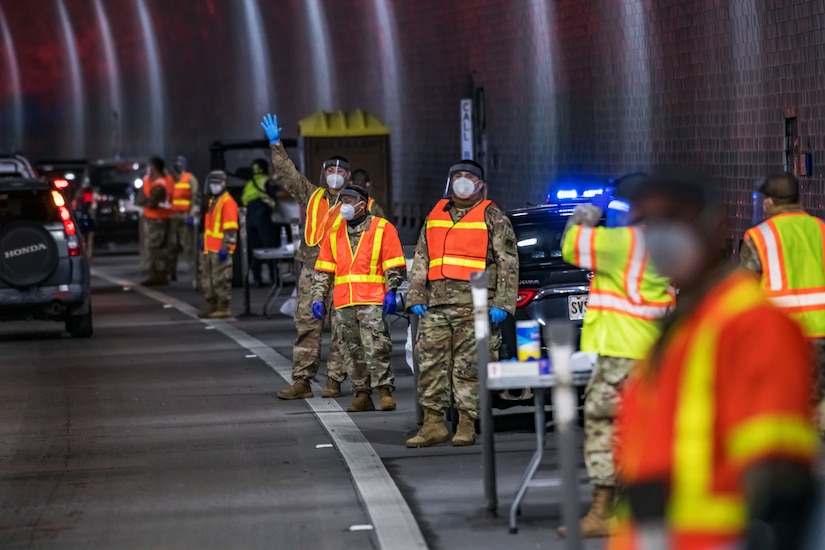
''Task Force Oahu is supporting Honolulu County's efforts to mitigate the spread of COVID-19 while meeting the general public's needs, such as safety, security and community health protection,'' said Army 1st Sgt. Lane Martinez, the senior noncommissioned officer assigned to Company Bravo with Task Force Oahu, HING JTF. ''Two units from the HING are also assisting the city and county of Honolulu by providing onsite surge testing registration support.''
Oahu leaders came up with a solution to temporarily use Hawaii's largest interstate, the John A. Burns Freeway (H-3), and it's Tetsuo Harano Tunnels as drive-thru test sites. Normal access in both directions on the H-3 were suspended and only people interested or registered to participate in the drive-thru COVID-19 surge tests were allowed to access the freeway.
''This is a remarkable, one-of-a-kind collaboration,'' said Hawaii Gov. David Ige. ''The H-3 freeway is a place where we can do mass testing without disrupting lives and traffic in urban neighborhoods.''
Three officers with the task force shared their experiences of taking a COVID-19 test themselves at the H-3 test site. They handed their pre-registration forms to a fellow guardsman wearing a safety vest, gloves, a KN95 mask and a face shield. He shortly thereafter returned their forms along with individual test kits each containing a labeled vial, nasal swab and napkin. Then the guardsman instructed the driver to reenter the flow of traffic and continue further into the tunnel to an open station manned by nurses who provided guidance on performing the self-administered swab test.
Army Col. Michael Tougher III, commander of Task Force Oahu, was excited to see soldiers and airmen supporting the registration for surge testing and remarked on its simplicity.
''It was much quicker than I expected," Tougher said "It seemed to be well organized and well run. Overall, I thought the testing was simple and did not feel too invasive, not uncomfortable.''
Guardsmen were stationed at both entries of the tunnels wearing personal protective equipment. The tunnels are equipped with powerful heating, ventilation and air conditioning systems, making it safe for workers wearing PPE while minimizing their exposure to carbon monoxide. Martinez recognizes the similarities at the H-3 site compared to other sites, noting some of its advantages and challenges.
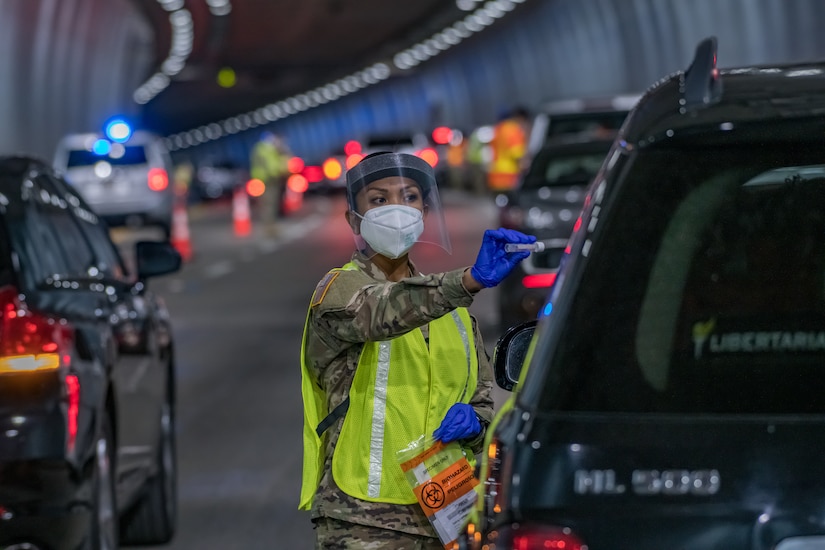
''The H3 site is similar to other surge test sites, as they have been categorized as either drive-up or walk-up,'' Martinez said. ''As a drive-up site, the H-3 location provided more protection from the elements, but the tunnel added the challenges of channeled wind and vehicle noise.''
Conducting COVID-19 support on a freeway is unprecedented for the Hawaii National Guard. The soldiers and airmen who are a part of the task force have deployed to war zones, supported communities after hurricanes and lava flows, but with COVID-19, everything that they have been asked to do is new. Airport medical screening, distributing PPE to communities, swabbing prisoners for the virus and assisting the Hawaii Health Department with COVID-19 mapping.
According to Army Lt. Col. Wesley Kawakami, former commander of the HING element on the island of Hawaii, the test wasn't bad at all.
''It was very comfortable,'' Kawakami said. ''The size of the swab is as big as a coffee stirrer. I would do it again.''
For Army 2nd Lt. Alnor Cabonce, this was his first COVID-19 swab test and first experience witnessing surge test operations. He understands that Hawaii is going through a difficult time and is hopeful that these opportunities will help the state get well soon.
''It's important to have these tests because it allows us to determine how many people actually have COVID,'' Cabonce said. ''I think, overall, it's better to get tested so that there is data to analyze and improve upon the way we’ve been combating COVID."
About 800 guardsmen support more than three-dozen missions carried out on a daily basis on six islands. The guard works alongside its partners at all levels of government, healthcare organizations and volunteers, and together they are trying to keep the frontlines safe and the people of Hawaii informed.
(Army 1st Lt. Anyah Peatross is assigned to the State of Hawaii, Department of Defense).